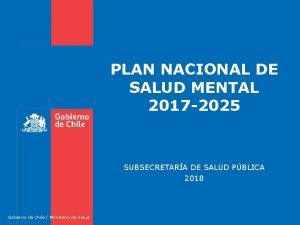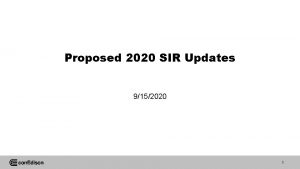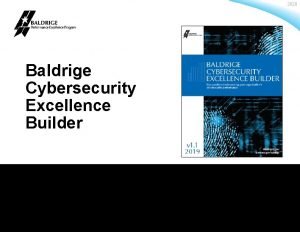Contracts for Excellence FY 2017 2020 Proposed Plan












- Slides: 12

Contracts for Excellence FY 2017 2020 Proposed. Plan: July 2016 Borough Hearing July 2019

Contracts for Excellence (C 4 E) Overview Ø NYCDOE receives Foundation Aid from the State, making up a portion of the overall budget. Ø A November 2006 Court of Appeals decision stated that every public school child in the State has a right to a "sound basic education" and that the State has the responsibility to increase funding for New York City's public schools. • As a result of this court decision, the New York State Legislature passed legislation requiring that, for each school district that has at least one school that requires academic progress or is in need of improvement, the school district would receive an increase in foundation aid and a portion of that foundation aid would be subject to the categorical spending requirements of the Contract for Excellence. Funds were first received in the 2007 -2008 school year. Ø These funds, under State law, must be distributed to schools that meet certain requirements and must be spent by those schools in designated program areas, as set forth in the Contract for Excellence legislation. 2

Contracts for Excellence (C 4 E) Requirements 1. Funds must support specific program initiatives: Ø Class Size Reduction – opening additional class sections, creating more classrooms or school buildings, assigning more than one teacher to a classroom, and other approved methods, to facilitate student attainment of State learning standards, with priority given to pre-K through grade 12 students in overcrowded schools, particularly those requiring academic progress, schools in need of improvement, schools in corrective action, and schools in restructuring status Ø Time on Task – programs focusing on students who may require additional or increased individualized attention in order to raise achievement Ø Teacher & Principal Quality Initiatives – programs supporting development & retention of high quality teachers and principals for raising achievement in struggling schools Ø Middle & High School Restructuring – instructional and structural changes in middle and high schools to support class size reduction and raise achievement in struggling schools Ø Full-Day Pre-Kindergarten Programs Ø Model Programs for English Language Learners – programs aimed at supporting schools in adopting “best practices” for raising achievement among English Language Learners 3

Contracts for Excellence Requirements (cont’d) 2. Funds should be used towards meeting schools’ overall educational goals as outlined in the School Comprehensive Educational Plan (SCEP) and must be allocated predominantly to students with the greatest educational needs, such as Ø English Language Learners Ø Students in Poverty Ø Students with Disabilities Ø Students with Low Academic Achievement or At Risk of Not Graduating 3. Funds must supplement, not supplant, local funding or other grants: Ø Expenditures made using C 4 E funds must “supplement, not supplant” funding provided by the school district; however, SED has provided guidance explaining that certain expenditures may be paid for with C 4 E funds even though these programs or expenditures were originally or have been typically paid for by the district or by other grants. For example, if a program had been funded by a different grant, but that grant funding has been cut, then C 4 E funds can be used to fund the program. Ø For new or expansion of existing programs only 4

Contracts for Excellence 2018 -2019 Ø The New York State 2019 -2020 Budget continues Contract for Excellence requirements for New York and maintains the same funding level for the Contracts for Excellence allocation as was provided in the 2018 -2019 school year. Ø In FY 2020, the State has not given DOE any additional C 4 E funding above the amount it provided last year. • NYCDOE is in “maintenance of effort” status, meaning that C 4 E funds will be used to maintain programs that were approved in prior years. Ø The total C 4 E amount for FY 2020 is $531 million, out of which $183 million is embedded in Fair Student Funding, which is the primary funding source for schools. Fair Student Funding is allocated based on student educational attributes, including ELL, Individualized Education Program (IEP), academic proficiency, and poverty status. Details for Fair Student Funding can be found by visiting: www. nycenet. edu/offices/finance_schools/budget/DSBPO/allocationmemo/fy 19_20/fy 20_docs/fy 2020_sam 001_1 b. htm Ø The remaining $348 million is distributed to schools through school allocation memos, also known as “SAMs”. Ø This presentation explains how the $348 million is allocated. 5

State Funding Breakdown STATE FUNDS FY 20 $531 million $348 M RESTRICTED (funds must be used $183 M UNRESTRICTED (funds not subject to C 4 E according to NYSED C 4 E guidelines) restrictions, may be used as needed) $183 million $348 million Funds subject to C 4 E $318 million $30 million Distributed to schools that were underfunded at the time of conversion to Fair Student Funding in 2008 “Maintenance of Effort” for existing priorities Restricted C 4 E funds 6

NYC’s 2019 -20 Preliminary C 4 E Plan How We Propose to Allocate the $348 Million Restricted Funds Maintenance of Effort $30 million 9% Targeted Allocations $104 million 30% Discretionary Allocations $214 million 61% The FY 2020 Contracts for Excellence allocations described in this plan are preliminary. Funds are subject to a public engagement process and approval by the State Education Department. Please note that distribution of all funds is subject to allocation guidelines as specified in State regulations. 7

Discretionary Allocations to Schools Amount $214 million in restricted Contracts for Excellence funds were released to 1, 400+ schools in May 2019. 61% of total restricted Contract funds. Ø Continuity of service for existing C 4 E programs. Use Ø However, if a school cannot maintain effort because of significant changes in its student population or its overall instructional strategy, it could choose to reallocate funds to a different allowable program area. 8

Targeted Allocations to Schools Amount About $104 million of C 4 E funds were targeted for specific programs. Schools receiving allocations were chosen based on a) overall student need and b) capacity to carry out the specific programs. 30% of total restricted Contract funds Funds will be allocated directly to schools for specific programs, including but not limited to: Ø $90 million – Integrated Co – Teaching Classrooms (ICT) (Formerly Collaborative Team Teaching (CTT)) Use Ø $9. 1 million – Full-Day Pre-K Ø $4. 7 million – Autism Spectrum Disorder (ASD) Classrooms Maintenance of Effort Amount $30 million 9% of total restricted Contract funds Use The Department proposes to spend these funds to maintain summer programs impacting the students with the lowest academic achievement in the City. 9

How C 4 E Dollars Are Spent Expenditures for the $348 Million Restricted Funds Other than Personnel Services $9. 4 million 3% Pupil Personnel Service Providers $17 million 5% Teachers $322 million 92% Pupil Personnel Service Providers Other than Personnel Services Assistant Principals & Principals (<0. 1% $83, 143) 10

Class Size as an Allowable Activity During the 2019 – 2020 School Year For the 2019 -2020 school year, the DOE will continue its efforts to reduce class size, one of the allowable activities for which Contracts for Excellence funds may be spent pursuant to the C 4 E legislation, in the following ways: Ø Last year, NYCDOE focused on class size reduction in the Renewal School Program. These schools align well with the legal requirements of Contracts for Excellence. Ø For the 2019 -2020 school year, NYCDOE will continue to focus on the lowest performing schools in its class size reduction efforts. The New York State Commissioner of Education has determined that the five-year Class Size Plan created in 2007, when the C 4 E legislation was issued, is no longer in effect. 11

Public Comment We will take public feedback into account in the coming months as we continue to develop a citywide Contracts for Excellence plan. The deadline for submitting public comments will be August 31, 2019. The public may comment on any aspect of the plan, including: How schools are planning to spend their discretionary funds within the six allowable program areas Ø How the DOE is allocating targeted Contract funds to schools Ø The public comment process Educators, parents, and all other members of the New York City community with feedback should e-mail us at Contracts. For. Excellence@schools. nyc. gov 12
 Local clinical excellence awards 2022
Local clinical excellence awards 2022 Plan nacional de salud mental 2017 a 2025
Plan nacional de salud mental 2017 a 2025 Salon marketing plan 2017
Salon marketing plan 2017 Ict strategy and action plan
Ict strategy and action plan Fspos vägledning för kontinuitetshantering
Fspos vägledning för kontinuitetshantering Typiska novell drag
Typiska novell drag Nationell inriktning för artificiell intelligens
Nationell inriktning för artificiell intelligens Ekologiskt fotavtryck
Ekologiskt fotavtryck Varför kallas perioden 1918-1939 för mellankrigstiden?
Varför kallas perioden 1918-1939 för mellankrigstiden? En lathund för arbete med kontinuitetshantering
En lathund för arbete med kontinuitetshantering Särskild löneskatt för pensionskostnader
Särskild löneskatt för pensionskostnader Personlig tidbok
Personlig tidbok A gastrica
A gastrica























